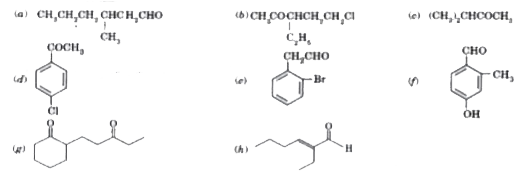Oxidation of (CH3)2C−CHCH2CH3 with hot alkaline KMnO4 gives Solution in Telugu
(CH3)−C∣OHH−CH3&CH3CH2CH2OH
(CH3)2C=O&CH3CH2COOH
(CH3)2CHCOOH&CH3CH2COOH
(CH3)2C(OH)CH(OH)CH2CH3
The correct Answer is:B
Two moles of brignard reagent used 
H3C−C∣CH3=CH−CH2−CH3KMnO4−−−−→OH− So, H3C−O∣∣C−CH3+H3C−CH2−COOH
Topper's Solved these Questions
- BOOK - AAKASH SERIESCHAPTER - CARBOXYLIC ACIDS EXERCISE - PRACTICE SHEET-1 (More than one correct answer questions)5videos
CARBOXYLIC ACIDS
- BOOK - AAKASH SERIESCHAPTER - CARBOXYLIC ACIDS EXERCISE - PRACTICE SHEET-1 (Linked comprehension Type Questions)6videos
CARBOXYLIC ACIDS
- BOOK - AAKASH SERIESCHAPTER - CARBOXYLIC ACIDS EXERCISE - LEVEL-II LEXTURE SHEET (Exericse-IV) (Integer answer type Questions)9videos
CARBOXYLIC ACIDS
- BOOK - AAKASH SERIESCHAPTER - CARBOHYDRATESEXERCISE - Practice Sheet-530videos
CARBOHYDRATES
- BOOK - AAKASH SERIESCHAPTER - CARBOXYLIC ACIDS AND DERIVATIVESEXERCISE - CONVERSIONS19videos
CARBOXYLIC ACIDS AND DERIVATIVES
Similar Questions
Which of the following compounds undergo nucleophilic substitution reaction
02:41View SolutionAn organic compound (A) of molecular weight 135 on boiling with NaOH evolves a gas which gives white dense fumes on bringing a rod dipped in HCl near it. The alkaline solution thus obtained on acidification gives the precipitate of a compound (B) having molecular weight 136. Treatment of (A) with HNO2 also yeilds (B), whereas its treatment with Br2/KOH gives (C). compound (C) reacts with cold HNO2 to give(D), which gives red colour with ceric ammonium nitrate. On the other hand(E) an isomer of (A) on boiling with dil HCl gives an acid (F), having molecular weight 136. On oxidation followed by heating, (F) gives an anhydride (G) which condenses with benzene in presence of AlCl3 to give anthraquinone.
Structrual formula of compound (A) is01:05View SolutionNo of positional isomers possible for benzene dicarboxylic acid
03:27View SolutionD-tagatose is a 2-ketohexose which forms same osazone as D-galactose. What is the structure of D-tagatose
08:10View SolutionMethanol to acetic acid
01:28View Solution(CH3)2C=CHCOCH3 can be oxidized to (CH3)2C=CHCOOH by:
02:50View SolutionThe compound CH3−CH3∣C=CH−CH3 on reaction with NaIO4 in the presence of KMnO4 gives
01:12View SolutionA compound X (C5H8) reacts with ammoniacal AgNO3 to give a white precipitate, and on oxidation with hot alkaline KMnO4 gives the acid, (CH3)2CHCOOH. Therefore , X is
02:50View SolutionGive IUPAC names of the following :
(a)CH3CH2CH2CHCH2∣CH3CHO(b)CH3COCHCH2CH2Cl (c)(CH3)2CHCOCH3
 04:44View Solution
04:44View SolutionOn vigorous oxidation by permanganate solution (CH3)2C=CH−CH2CH3 gives
00:44View SolutionWhich of the following reaction gives (CH_3)_2 CHCH_2 COCH_3
03:04View SolutionArrange the following
CH3CH2CH2Cl(I),CH3CH2−CHCl−CH3(II),(CH3)2CHCH2Cl(III)and(CH3)3C−Cl(IV) in order of decreasing tendency towards S2N reaction02:39View Solution(CH3)2NHKMnO4−−−−→A,(CH3)2NHH2SO4−−−→B Here A and B are
01:28View SolutionGive the IUPAC names of the compounds. Classify them as alkyl, allylic, benzylic, vinylic and aryl halides and also as primary, secondary and tertiary halides. (i ) (CH_3)_3 C CH_2 CH (Cl) CH_3 (ii ) CH_3 CH_2 CH=CHCH_2 Cl, (iii ) (CH_3)_2 CHCH_2 CH=C (Cl) CH_2 CH_3 and (iv ) C_6 H_5 C (Cl ) CH_3)_2
View SolutionIUPAC name of (CH3)2CHCH2CH2Br is
03:54View Solution

